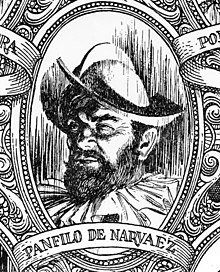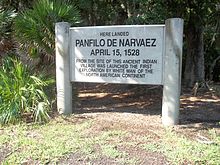
Hernán Cortés de Monroy y Pizarro Altamirano, 1st Marquess of the Valley of Oaxaca was a Spanish conquistador who led an expedition that caused the fall of the Aztec Empire and brought large portions of what is now mainland Mexico under the rule of the King of Castile in the early 16th century. Cortés was part of the generation of Spanish explorers and conquistadors who began the first phase of the Spanish colonization of the Americas.

Diego Velázquez de Cuéllar was a Spanish conquistador and the first governor of Cuba. In 1511 he led the successful conquest and colonization of Cuba. As the first governor of the island, he established several municipalities that remain important to this day and positioned Cuba as a center of trade and a staging point for expeditions of conquest elsewhere. From Cuba, he chartered important expeditions that led to the Spanish discovery and conquest of the Aztec Empire.

Álvar Núñez Cabeza de Vaca was a Spanish explorer of the New World, and one of four survivors of the 1527 Narváez expedition. During eight years of traveling across what is now the US Southwest, he became a trader and faith healer to various Native American tribes before reconnecting with Spanish civilization in Mexico in 1536. After returning to Spain in 1537, he wrote an account, first published in 1542 as La relación y comentarios, which in later editions was retitled Naufragios y comentarios. Cabeza de Vaca is sometimes considered a proto-anthropologist for his detailed accounts of the many tribes of Native Americans that he encountered.
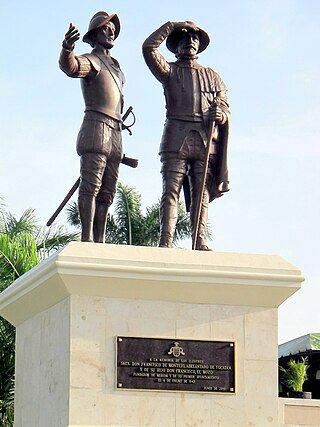
Francisco de Montejo was a Spanish conquistador in Mexico and Central America.

The Narváez expedition was a Spanish expedition started in 1527 that was intended to explore Florida and establish colonial settlements. The expedition was initially led by Pánfilo de Narváez, who died in 1528. Many more people died as the expedition traveled west along the unexplored Gulf Coast of the present-day United States and into the American southwest. Only four of the expedition's original members survived, reaching Mexico City in 1536. These survivors were the first known non-Native Americans to see the Mississippi River, and to cross the Gulf of Mexico and Texas.
Estevanico, also known as Mustafa Azemmouri and Esteban de Dorantes and Estevanico the Moor, was the first person of African descent to explore North America. He was one of the last four survivors of the Narváez expedition, along with Álvar Núñez Cabeza de Vaca, Andrés Dorantes de Carranza, and Alonso del Castillo Maldonado.
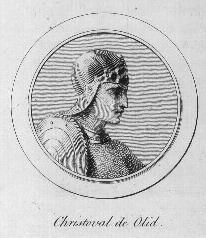
Cristóbal de Olid was a Spanish adventurer, conquistador and rebel who played a part in the conquest of the Aztec Empire and present-day Honduras.
Adelantado was a title held by some Spanish nobles in service of their respective kings during the Middle Ages. It was later used as a military title held by some Spanish conquistadores of the 15th, 16th and 17th centuries.
Juan Velázquez de León was a Spanish conquistador, who along with Hernán Cortés participated in the third Spanish expedition to continental America in 1519. He was distinguished by being relative of the then Governor of Cuba Diego Velázquez, but overall served Hernán Cortés and the cause of the Conquest. Cortés gave Juan the daughter of Maxixcatzin, baptized as Doña Elvira, after the Tlaxcallan's made peace with the Spanish.
Cabeza de Vaca is a 1991 Mexican film about the adventures of Álvar Núñez Cabeza de Vaca, an early Spanish explorer, as he traversed what later became the American South. He was one of four survivors of the Narváez expedition and shipwreck. He became known as a shaman among the Native American tribes he encountered, which helped him survive. His journey of a number of years began in 1528. After his return to Spain, he published his journal in 1542. The screenplay by Guillermo Sheridan and Nicolás Echevarría is based on this journal.

Francisco de Garay was a Spanish Basque conquistador.
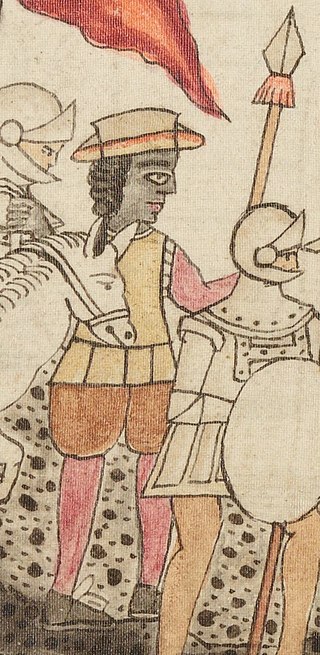
Juan Garrido was an Afro-Spaniard conquistador known as the first documented black person in what would become the United States. Born in West Africa, he went to Portugal as a young man. In converting to Catholicism, he chose the Spanish name Juan Garrido. He is the first known African to arrive in North America.
The exploration of North America by European sailors and geographers was an effort by major European powers to map and explore the continent with the goal of economic, religious and military expansion. The combative and rapid nature of this exploration is the result of a series of countering actions by neighboring European nations to ensure no single country had garnered enough wealth and power from the Americas to militarily tip the scales over on the European continent. It spanned the late 15th to early 17th centuries, and consisted primarily of expeditions funded by Spain, England, France, and Portugal. See also the European colonization of the Americas.
Andrés González de Barcia was a Spanish historian and one of the founders of the Royal Spanish Academy.
Alonso del Castillo Maldonado was an early Spanish explorer in the Americas. He was one of the last four survivors of the original members of the 1527 Narváez expedition, along with Álvar Núñez Cabeza de Vaca, Andrés Dorantes de Carranza and his African slave Estevanico. They were the early non-native people to travel and be enslaved in the Southwest region of the modern United States. Castillo Maldonado lived with a Native American tribe in Texas in 1527 and 1528.
Andrés Dorantes de Carranza, was an early Spanish explorer in the Americas. He was one of the four last survivors of the Narváez expedition, along with Álvar Núñez Cabeza de Vaca, Alonso del Castillo Maldonado, and Estevanico, Dorantes' slave of African descent.
Alonso de Solís was a soldier and explorer who served as governor of Florida between April and July 4, 1576, when he was killed. He also participated in the Narváez expedition as royal inspector of mines.
Xicomecoatl, Chicomácatl, or as he was referred to as by the Spanish conquistador Bernal Díaz del Castillo, "Cacique Gordo", was the ruler of the city of Cempoala while it was under control of the Aztec Empire.

The Battle of Cempoala was fought on 27 May 1520 at Cempoala, Mexico between the forces of Pánfilo de Narváez and the forces of Hernán Cortés, which were supported by Chinantec warriors.
